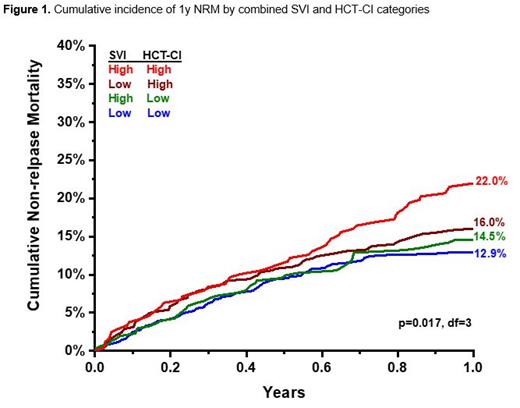Abstract
Introduction: Allogeneic hematopoietic cell transplantation (HCT) is an established treatment for malignant and non-malignant hematologic diseases. However, HCT is not without risk; rates of non-relapse mortality (NRM) remain high during the first year after transplantation. Clinical prediction models have been developed to identify those at increased risk for NRM after HCT, but the impact of social determinants of health on transplant outcomes has not been well characterized. To address this gap, we evaluated the relationship between census tract-level social vulnerability and 1y NRM following HCT. Methods: Using a retrospective cohort design, this study included 1,602 patients living in California (CA) who underwent a first allogeneic HCT between 2013-2019 at City of Hope. Demographic, insurance, disease, treatment, and survival information was abstracted from the medical records. Social vulnerability according to the census tract was measured using the Social Vulnerability Index (SVI), a tool developed by the Center for Disease Control. SVI comprises 4 themes (socioeconomic status [SES], household composition & disability, minority status & language, and housing & transportation) constructed using 15 social and environmental variables from the US Census. This study used the overall SVI and individual theme scores which were ranked across the CA census tracts as percentiles; the scores ranged from 0 (least vulnerable) to 100 (most vulnerable). Scores were assigned to patients using their address at the time of HCT. Fine-Gray multivariable regression was used to evaluate the association between SVI, tertiles of SVI, and 1y NRM, adjusted for age at HCT, performance status, relapse risk (RR), human leukocyte antigen (HLA) match, and HCT-Comorbidity Index (HCT-CI). We also performed subgroup analysis to examine the risk of NRM across combined SVI and HCT-CI categories: 1) lower two SVI tertiles (low social vulnerability) and low (<3) HCT-CI score (reference); 2) low social vulnerability and high (≥3) HCT-CI score; 3) high social vulnerability (upper SVI tertile) and low HCT-CI score; 4) high social vulnerability and high HCT-CI score. Results: Median age at HCT for the cohort was 52.0 years (IQR 33.0-63.0); 55.8% were male; 44.6% were non-Hispanic white; 59.1% had private insurance. The most common diagnosis was acute myeloid leukemia (40.7%) and 54.1% received reduced intensity conditioning. In the first year after HCT, 357 patients died (NRM 15.3% [n=245], relapse-related 7.0% [n=112]). In multivariable analysis, there was a significant linear relationship between worsening overall SVI and the risk of 1y NRM (SVI coefficient=0.0056, 95% confidence interval [CI]: 0.001-0.010, p=0.017). Patients in the highest SVI tertile (most socially vulnerable) had a 1.4-fold (HR=1.41, 95%CI: 1.08-1.83, p=0.011) risk of 1y NRM compared to those in the lowest two SVI tertiles. When the 4 themes were evaluated individually, increased risk for 1y NRM was found for the highest SVI tertiles for SES (HR=1.43, 95% CI: 1.10-1.86, p=0.008), household composition & disability (HR=1.32, 95% CI: 1.02-1.71, p=0.036), and minority status & language (HR=1.40, 95% CI: 1.08-1.83, p=0.013). When the themes were considered together in one regression model, only the highest SVI tertile for SES retained significance. The one-year cumulative incidence of 1y NRM was highest (22.0%) for patients who had both high social vulnerability and a high HCT-CI score at HCT (Figure 1); in adjusted analysis, patients who had both high social vulnerability and HCT-CI scores were at a 1.6-fold (HR=1.64, 95% CI: 1.21-2.24, p=0.002) risk of 1y NRM compared to the rest of the patients. Conclusion: Among allogeneic HCT recipients, SVI, especially within the theme of SES, was an independent predictor of 1y NRM, after adjusting for RR, performance status, age at HCT, HLA match, and HCT-CI score. Patients with both the highest social vulnerability and high comorbidity had particularly increased risk of 1y NRM, suggesting that in addition to clinical risk factors, local social and environmental factors play an important role in health outcomes following HCT. These findings may inform more targeted approaches for needs assessment during and shortly after HCT, allowing for timely interventions to improve health outcomes in at-risk allogeneic HCT patients.
Artz: Radiology Partners: Other: Spouse has equity interest in Radiology Partners, a private radiology physician practice. Forman: Allogene: Consultancy; Lixte Biotechnology: Consultancy, Current holder of individual stocks in a privately-held company; Mustang Bio: Consultancy, Current holder of individual stocks in a privately-held company.


This feature is available to Subscribers Only
Sign In or Create an Account Close Modal